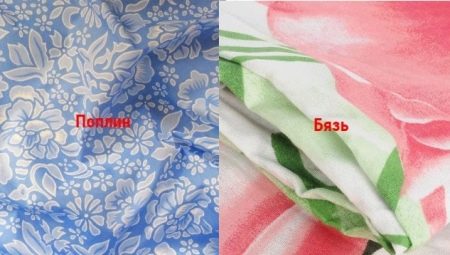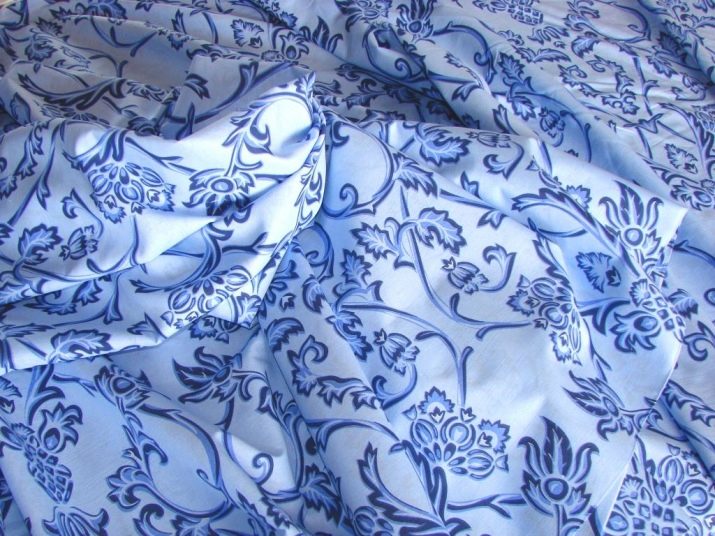Poplin or coarse calico - which is better?

Bed linen is an essential element for creating a cozy home and a comfortable sleep. The determining factor is the fabrics from which the bedding is made. It is unlikely that it will be pleasant for you to fall asleep and wake up on the many pellets that have formed on the sheet. That is why only selected materials can become the basis for bed linen. Calico or poplin: which fabric is best for bed and can withstand multiple washings?

Characteristics of fabrics
Poplin
Poplin is a very high quality and practical fabric that has many uses. The material first appeared in Avignon and was used to create the clothes of the Pope and those close to him. Poplin means “papal” in translation, which is very symbolic.
In Russia, they got acquainted with the material in the 18th century, and because of the similarity in weaving, it was called European coarse calico. The difference lies in the weaving technique. Poplin is obtained by joining thick and thin threads, sometimes synthetic additives are present.
Artificial blotches do not make the fabric worse, on the contrary, it acquires an expensive matte sheen.
The very first fabrics called poplin were made from high-quality silk.The Pope and his approach did not recognize any other materials. Modern fabric has several varieties that differ in composition.

- Wool + silk. This combination is used in the manufacture of premium bedding.

- Cotton + synthetic additives. Inexpensive fabric from which practical bedding is made. The disadvantage can be the appearance of pellets after prolonged use.

- Pure cotton. The most environmentally friendly material that perfectly absorbs moisture and allows air to pass through. Poplin of this type has similar qualities to silk, but is much cheaper.

One of the best materials is produced in India.
Papal fabric is made by double-sided weaving using threads of various thicknesses. The material has many positive qualities.
- Density. The threads are very close to each other, the weaving can be invisible if you do not look closely at it. But despite this, poplin is very soft and smooth, pleasant to the touch.

- Wear resistance. Even after numerous washes, the material retains its original appearance and does not lose its quality.

- Preservation of the form. The fabric is practically wrinkle-free, so you don't have to waste energy to iron it after washing. It is enough just to run with an iron, and you will get an even, smooth fabric.

- The ability to pass air. Poplin is able to "breathe" and absorb moisture. The linen can be used all year round, in cool weather it keeps you warm, and in hot weather it cools.

- Availability. The fabric has average prices, so many can afford it.

It is necessary to take into account some features when caring for poplin products. The fabric should be washed at low temperatures, no more than 30 degrees. Turn garments inside out before washing so that the design is not exposed to strong water and detergents.
Chemical bleaches are detrimental to noble fabrics, so it is better to use more natural laundry detergents.
If it is possible not to wring out the poplin after washing, then be sure to take this into account. The fabric will dry well as it is, the main thing is that there are conditions for this. Dry the fabric in the shade, as exposure to the sun can negatively affect the color of the laundry.

Calico
Coarse calico appeared in Russia in the 16th century, until that time the fabric was also used, but the one that was brought from Asia. This is where the name of the material came from, like the warped Turkish word "Asia". The fabric immediately gained popularity due to its inexpensive cost and durability.
Initially, coarse calico was used for sewing underwear for soldiers, made linings for coats and light women's dresses. Already at that time there were several types of this fabric, including printed and one-colored.
If you rely on the Russian state standard, then this fabric is made from pure cotton. Material imported from China or Pakistan may contain about 15 percent polyester. But natural fabric, which is a weaving of thick threads, is still in great demand. The threads used are quite thick, and you can clearly see how they are intertwined.

Calico is an environmentally friendly material that is durable and practical, the fabric is ideal for use in everyday life. There are four main types of coarse calico.
- Harsh. Calico in its original form, not softened and not bleached. The fabric is rather coarse, used for sewing workwear and upholstery.

- Bleached. Delicate bedding fabric, which is most often used in hotel services.

- Plain dyed. Has the same structure as bleached. It is dyed in one color and used when sewing tablecloths, kitchen towels and bed linen.

- Printed. Coarse calico with a pattern, the most beautiful and bright option. Bed linen and baby clothes are made from such fabric.

Calico fabric is resistant to frequent washing and high temperatures. For the laundry to be ironed better, it needs to be slightly moistened with water. Any means are suitable for washing, the material is not afraid of the effects of chemistry. The fabric is hypoallergenic, does not cause negative reactions even in strong allergy sufferers. It is also remarkable that the coarse calico is not electrified and does not stick to the body.
Fundamental differences
Many people often confuse coarse calico and poplin and do not see a significant difference between these materials. In fact, there is a difference, and it becomes noticeable with the frequent use of both types of material.
- The first difference is in the composition of the tissues. Coarse calico is made exclusively from cotton, so before it was even called paper fabric. Poplin can be made of pure cotton or with the addition of synthetics.
- Fabrics also differ in the size of the threads used for weaving. In the manufacture of coarse calico, longitudinal and transverse threads are of the same size; in the manufacture of poplin, threads of different thicknesses are used.
- These fabrics have different densities. Despite the fact that the coarse calico is a little denser, this does not mean that it is of better quality and stronger. As already mentioned, poplin consists of thicker threads, which allows it to be stronger than coarse calico.

It is difficult to judge which fabric is softer, both options are carefully processed, which makes them soft and pleasant to the body. The cost of materials depends on the composition and the country of origin. European coarse calico and poplin are more expensive than Russian ones, but this does not diminish the quality of domestic producers.
Comparison of the cost of fabrics from one country showed that coarse calico made in accordance with GOST can be more expensive than poplin.
Still, luxury poplin outperforms its opponent in value.
Bed linens made from these two materials are used in hotels, spas and hospitals. The only difference is that poplin is more often chosen by more expensive establishments, and coarse calico takes place in budgetary service sectors.


What is the best choice?
The choice of a particular fabric, in this case, coarse calico or poplin, is determined by the scope of their use. If you want to sew a beautiful, soft and pleasant-to-touch bedding set, then poplin will do just fine. The durability of the fabric will allow you to enjoy the laundry for a long time and then again make your choice in favor of this material. In addition to bed linen, poplin makes great bathrobes and kitchen towels.
Calico is often used for sewing bedding.
If you want to update your arsenal of bedding and save a lot on it, then turn your attention to coarse calico. Coarse calico is suitable for the manufacture of workwear; for this, a harsh raw material is used. If you want to sew any item of clothing, then coarse calico can also be used for these purposes. Of course, we are not talking about evening wear, but about comfortable home clothes.



How do they differ from satin and chintz?
If coarse calico and poplin have a similar structure and type of weaving, then satin and chintz differ significantly from them. Satin is considered a luxury material, used for sewing high-quality and beautiful bed linen, men's shirts, shirts, pajamas. The material has a higher cost.
As for the chintz, it is used for sewing light summer dresses and dressing gowns, baby diapers. In terms of its qualities, it is significantly inferior to coarse calico, poplin, and satin. Chintz has a rather loose texture, does not tolerate washing well and can greatly lose its shape.

If coarse calico, poplin and satin are used in the widespread production of bed linen, then chintz is absolutely not suitable for these purposes.
What to choose - calico, poplin or satin, see the video below.








